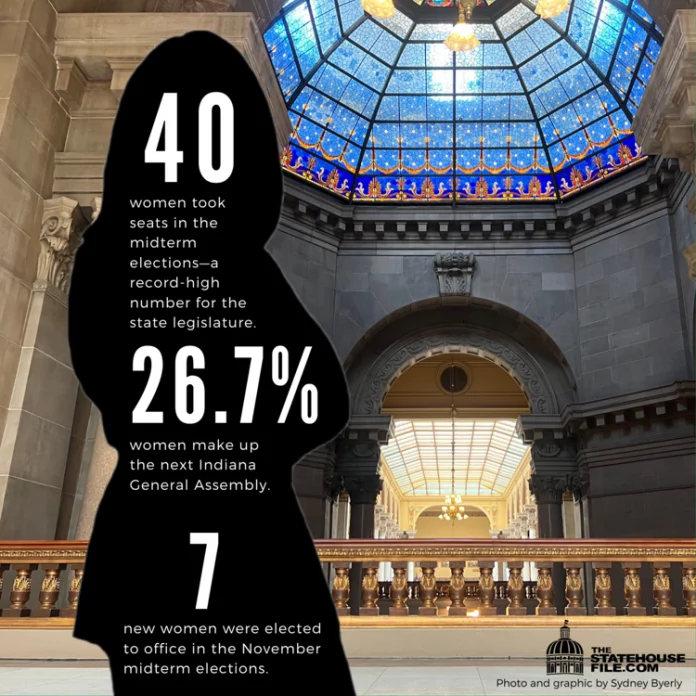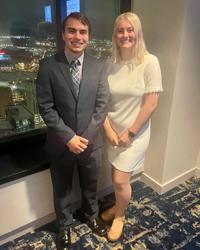BLOOMINGTON, Ind. – Indiana swimming and diving set a program record in the women’s 200-yard freestyle relay to highlight a solid first day at the Ohio State Fall Invitational on Thursday (Nov. 17) inside the McCorkle Aquatic Pavilion in Columbus, Ohio.
IU posted NCAA A cuts in all four relays raced on the first day of the midseason competition. IU swimmers and divers recorded 23 NCAA qualifying marks during the preliminary session and added 29 in evening finals.
IU’s quartet of sophomore Anna Peplowski, senior Ashley Turak, junior Elizabeth Broshears, and freshman Kristina Paegle finished in 1:27.77, six tenths of a second faster than the old mark, which Turak was part of during the 2020 Big Ten Championships. The freshman Paegle had the quickest split of the field, anchoring IU in a blazing fast 21.28. Turak also broke 22 seconds, going 21.85.
Paegle wrote her name in the record book again with IU’s third-best time in the 50-yard freestyle, swimming a 22.07 during prelims. The Bloomington native finished second in the event Thursday night, going 22.11 in her second attempt.
Senior Van Mathias kept his momentum going as the only swimmer to break 19 seconds in the men’s 200 freestyle relay with an 18.61 to anchor IU’s win in the event. Sophomore Finn Brooks’ 19.11 was the third-fastest split, as fellow sophomore Rafael Miroslaw (19.69) and junior Gavin Wight (19.30) made up the first two legs.
The same IU men’s 400 medley relay group that finished second at the national meet last season had its first showcase of the season and impressed. Senior Brendan Burns (45.36), sophomore Josh Matheny (51.11), junior Tomer Frankel (45.96) and sophomore Rafael Miroslaw (41.55) posted a 3:03.98, more than two seconds better than second place Virginia Tech. The fastest time coming into the day was 3:05.89. IU’s B relay posted a B cut, going 3:07.24 to place fourth.
The IU women went an A cut 3:30.60 to finish second in that race with three of the four swimmers from the earlier relay.
IU loaded the A finals in the women’s 500-yard freestyle and 200 IM, placing three of the top six finishers in both races. Sophomores Ching Hwee Gan and Mariah Denigan earned second and third place, respectively, in the first distance race of the week, while Tomer Frankel, going 1:44.57, led Indiana’s 2-4-6 placement in the individual medley.
Junior Anne Fowler was the runner-up on the women’s 3-meter springboard after improving her score by 85 points between prelims and finals. Fowler posted a 375.55 in the evening, just under seven points shy of Kentucky graduate Kyndal Knight. Sophomores Carson Tyler and Quinn Henninger were the top two scorers on the 1-meter board Thursday morning but settled for a third-place finish from Henninger (378.70) and a fifth-place showing from Tyler (359.95) in the second round.
TEAM SCORES
Women
- Ohio State – 711
- Indiana – 673.50
- Kentucky – 583
- Virginia Tech – 439
- UCLA – 374
- Notre Dame – 285.50
- Yale – 264
- Ohio – 170
- Navy – 136
t10. Cincinnati – 124
t10. Lindenwood – 124
- Miami – 32
- Pittsburgh – 20
Men
- Ohio State – 746
- Indiana – 702.50
- Virginia Tech – 476
- Notre Dame – 458
- Yale – 313
- Kentucky – 306
- Cincinnati – 283.50
- Lindenwood – 206
- Miami – 68
- Pittsburgh – 59
- Kenyon College – 22
RESULTS
Â
200 Freestyle Relay
Women
- Anna Peplowski (22.53), Ashley Turak (21.85), Elizabeth Broshears (22.09), Kristina Paegle (21.28) – 1:27.75 (NCAA A Cut)
- Ella Ristic (23.08), Makenzie Looze (22.52), Mya DeWitt (22.98), Chiok Sze Yeo (22.51) – 1:31.09
- Aislinn Holder (23.56), Mia Ristic (23.14), Kacey McKenna (23.34), Katharina Wrede (23.08) – 1:33.12
Men
- Rafael Miroslaw (19.69), Gavin Wight (19.30), Finn Brooks (19.11), Van Mathias (18.61) – 1:16.71 (NCAA A Cut)
- Tomer Frankel (19.93), Jack Franzman (19.55), Luke Barr (19.37), Brendan Burns (19.69) – 1:18.54
- Alex Stone (20.97), Joseph Radde (20.13), Ben Stevenson (20.69), Jasper Davis (20.42) – 1:22.21
500 Freestyle
Women
- Ching Hwee Gan – 4:41.58 (NCAA B Cut)
- Mariah Denigan – 4:41.89 (NCAA B Cut)
- Elyse Heiser – 4:43.39 (NCAA B Cut)
- Ella Ristic – 4:46.26 (NCAA B Cut)
- Maggie Wallace – 4:48.34
- Dominika Kossakowska – 4:54.08
- Katie Carson – 4:51.72
Men
- Warren Briggs – 4:17.77 (NCAA B Cut)
t5. Mikey Calvillo – 4:19.39 (NCAA B Cut)
- Jackson Carlile – 4:24.40
- Mason Carlton – 4:26.56
- Jacob Destrampe – 4:27.43
200 IM
Women
- Mackenzie Looze – 1:56.52 (NCAA B Cut)
- Noelle Peplowski – 1:57.49 (NCAA B Cut)
- Brearna Crawford – 2:01.59
- Cat Minic – 2:01.91
- Anna Freed – 2:02.49
- Avery Spade – 2:03.41
- Katie Forrester – 2:03.58
Men
- Tomer Frankel – 1:44.57 (NCAA B Cut)
- Jassen Yep – 1:44.99 (NCAA B Cut)
- Luke Barr – 1:46.38 (NCAA B Cut)
- Tristan DeWitt – 1:49.94
- Josh Matheny – 1:48.83
- Drew Reiter – 1:48.15
- Kai Van Westering – 1:48.49
- Alejandro Kincaid – 1:51.17
50 Freestyle
Women
- Kristina Paegle – 22.11 (NCAA B Cut)
t7. Anna Peplowski – 22.45 (NCAA B Cut)
- Ashley Turak – 22.34 (NCAA B Cut)
- Elizabeth Broshears – 22.67 (NCAA B Cut)
- Chiok Sze Yeo – 22.76 (NCAA B Cut)
t28. Mya DeWitt – 23.25
- Aislinn Holder – 23.64
- Kacey McKenna – 23.35
- Katharina Wrede – 23.50
- Mia Ristic – 23.85
Men
- Van Mathias – 19.38 (NCAA B Cut)
- Finn Brooks – 19.39 (NCAA B Cut)
- Rafael Miroslaw – 19.66 (NCAA B Cut)
- Gavin Wight – 19.67 (NCAA B Cut)
- Jack Franzman – 20.02
- Joseph Radde – 20.55
- Jacob Destrampe – 20.76
400 Medley Relay
Women
- Anna Peplowski (52.11), Mackenzie Looze (58.59), Elizabeth Broshears (52.36), Kristina Paegle (47.54) – 3:30.60 (NCAA A Cut)
- Kacey McKenna (52.82), Noelle Peplowski (58.76), Chiok Sze Yeo (53.72), Ashley Turak (48.56) – 3:33.86
Men
- Brendan Burns (45.36), Josh Matheny (51.11), Tomer Frankel (45.96), Rafael Miroslaw (41.55) – 3:03.98 (NCAA A Cut)
- Luke Barr (47.52), Jassen Yep (52.06), Finn Brooks (45.79), Van Mathias (41.87) – 3:07.24 (NCAA B Cut)











